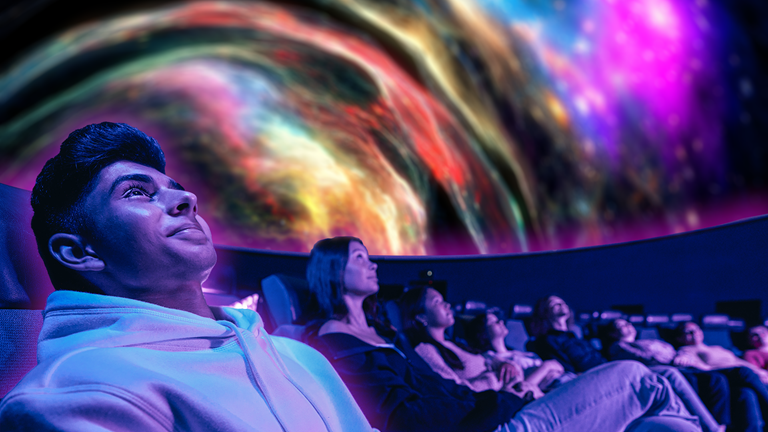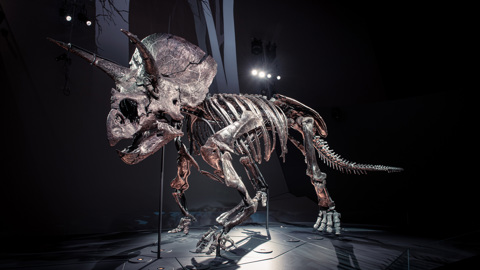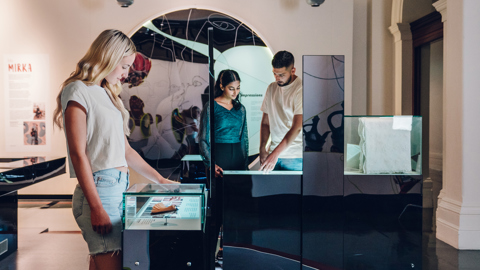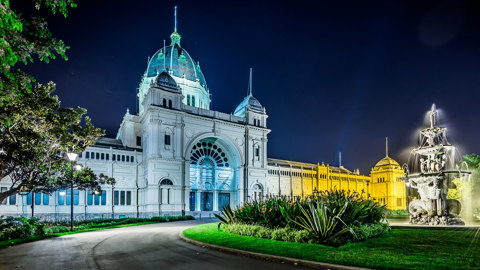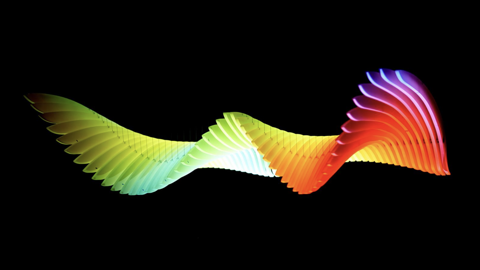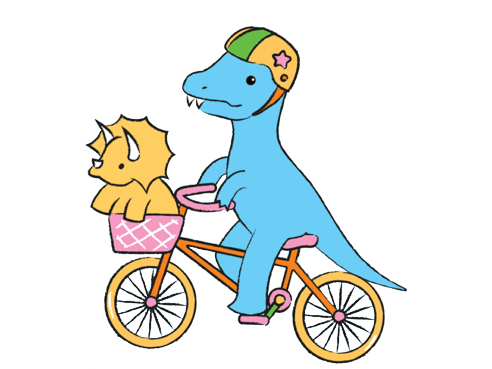Skynotes: February 2025
Upcoming events
Is the Moon mostly Earth material after all?
Contrary to the current theory of the moon forming principally from the debris of a protoplanet Theia colliding with the early Earth, a new study suggests the moon may actually be mostly Earth material with little contribution from the colliding body. Improved analysis techniques of lunar samples and Earth minerals has revealed a much closer similarity of oxygen ‘flavours’, or isotopes, in Earth’s mantle and the moon’s crust, as would be expected if the moon was principally Earth ejecta.
Explore:
Phys.Org – Moon’s origin
Another Auroral Light Show
Our correspondent Julian has captured not only the aurora but also at lower centre the Pointers (Alpha and Beta Centauri) leading to an inverted Southern Cross at left, with the broad band of the Milky Way rising at upper left. Green is common in aurora from excited oxygen, but in this case the reddish glow is from nitrogen molecules in the upper atmosphere being energised by collisions with high-speed particles of the solar wind funnelled into the polar regions of our planet’s dynamic magnetic field. The effect creates a fluctuating phenomenon not unlike curtains moving in a gentle breeze.
See “Aurora Delight” in Skynotes June 2024 for more on the beauty and science of aurora.
Melbourne Sun times
| Date | Rise | Set | Day length | Solar noon* |
|---|---|---|---|---|
| Saturday 1st | 6:33am | 8:33pm | 13:59hours | 1:33pm |
| Tuesday 11th | 6:45am | 8:23pm | 13:37hours | 1:34pm |
| Friday 21st | 6:55am | 8:10pm | 13:14hours | 1:33pm |
| Friday 28th | 7:03am | 8:01pm | 12:58hours | 1:32pm |
*When the sun is at its highest, crossing the meridian or local longitude.
Moon phases
| Phase | Date |
|---|---|
| First Quarter | Wednesday 5th |
| Full Moon | Thursday 13th |
| Third Quarter | Friday 21st |
| New Moon | Friday 28th |
Moon distances
Lunar apogee (furthest from Earth) is on Tuesday 18th at 404,882 km.
Lunar perigee (closest to Earth) is on Sunday 2nd at 367,457 km.
*When the sun is at its highest, crossing the meridian or local longitude.
Planets
Target Six Planets
Last month's skies featured and this month four planets at once will continue to be visible at Melbourne's latitude from around 10pm – Saturn and Venus very low in the west, Jupiter in the north, and Mars in the north-east. At the same time in the north-west a telescope should show faint Uranus and possibly much fainter Neptune. With the planets in orbit around the Sun at different distances and hence different speeds (faster for those closer to the Sun compared to slower ones further out), our view at night can capture one or two planets, sometimes several, and occasionally more.
Mercury is very close to the sun and although in our skies just before sunrise and after sunset, it will be very difficult to see after its recent passage behind the sun, its solar conjunction.
Venus remains visible from around 8:40pm in the west at twilight before it sets by 10pm. Its times will be a little earlier each evening as the month progresses.
Mars has passed opposition but remains clear in the north-east from 8:40pm before the red planet sets in the north-west by 3am. It too will appear a little earlier each night during the month.
Jupiter remains visible this month from 8:40pm in the north before setting by 1:30am in the west.
Saturn is drawing close to the Sun in our skies and is not visible as it about to move behind the sun for its solar conjunction.
Meteors
The alpha-centaurids and beta-centaurids are active from 2nd to 25th peaking on the 8th. They are different but it is difficult to distinguish between them. Occurring low in the south near the Two Pointers, they are not strong showers but often have fireballs and persistent trails. 25 per hour can occur but six per hour has been more usual.
See TheSky.com – Alpha Centaurids
Stars and constellations
In the East
High in the sky is Sirius, the brightest star at night and the principal star in Canis Major (Greater Dog). This is one of Orion’s two hunting dogs which is why Sirius is also referred to as The Dog Star. Directly below Sirius is the star Procyon which marks the location of Canis Minor, Orion’s smaller dog.
Many cultures have recognised the first evening appearance of Sirius as marking a special time during the year for religious, agricultural or other reasons. It sits 8.6 light years away making it the fifth nearest system to us and its energy output reflects a name appropriately derived from the Greek seirios, meaning glowing or scorching.
Sirius is, however, a binary system. Sirius A is twice the mass of our sun, almost 17 times as large and 25 times as luminous. Small faint Sirius B, however, is a white dwarf about the size and mass as the Earth and is the remnant core of a star that was once similar to our sun. Sirius A and B orbit their mutual centre of mass every 50 years.
In the North-West
Directly north lies Orion, the hunter, seen in the southern hemisphere upside down. The famous three stars of his belt are Mintaka, Alnilam and Alnitak.
From his belt and going upper right is a line of stars which forms his scabbard, in the centre of which is the beautiful Orion Nebula, a vast stellar nursery 1500 light years from us. Upper left in Orion is the blue-white supergiant star Rigel (one of his feet) and lower right is the red supergiant Betelgeuse (one of his shoulders).
Orion’s three belt stars also mark the base of the southern hemisphere’s Saucepan asterism.
To the north-west is the open star cluster the Hyades 153 light years away and forms the inverted V of the head of Taurus, the bull. The red-giant star Aldebaran at its lower right corner is much closer to us at 65 light years.
To the left is the Pleiades, a close cluster of young blue stars 430 light years from us. These stars are formed together and are generally bound together under their mutual gravitational attraction, although over millions of years it is expected the cluster will disperse. Also known as The Seven Sisters and for many cultures across the world they represent a group of women.
In the South-East to South-West
The Southern Cross and the Two Pointers, (Alpha & Beta Centauri) are low in the south-east. In the south-west are the two small nearby galaxies, the Magellanic Clouds, named in honour of 16th century explorer Ferdinand Magellan who embarked on the first circumnavigation of the globe. They look like faint fuzzy patches but are best seen away from city lights. The earliest known physical depictions of them are in petroglyphs in South America.
Arcing across the night sky, and slowly wheeling as the Earth rotates during the night to the east, is the majestic Milky Way - billions of distant stars of our galaxy.
In visible light our view of the galaxy is largely restricted to our local spiral arm which is one of several that sit in the disc of the galaxy. We are looking ‘edge on’ into the flat disc of billions of stars. By contrast, the two darker sides of the night sky a view out of the galactic plane. In those directions we seen far fewer stars for a few thousand light years before intergalactic space begins.
International Space Station
ISS orbits every 90 minutes at an average distance of 400 km. It appears like a bright star moving slowly across the night sky.
Some bright passes are below for the Melbourne region.
Morning
Wednesday 5th 6:04am-6:10am, South-West to North-East
Evening
Thursday 6th 9:54pm to 9:58pm, North-North-West to East
Sunday 9th 8:59pm to 9:06pm, North-West to South-East
Wednesday 26th. 9:02pm to 9:08pm, South-West to East-North-East
Heavens Above gives predictions for visible passes of space stations and major satellites, live sky views and 3D visualisations. Be sure first to enter your location under ‘Configuration’.
On this day
1st 2003, the Space Shuttle Columbia (USA) disintegrated on re-entry killing all seven astronauts and halting the shuttle program for over two years.
1st 1970, US astronomer Vera Rubin finds evidence of ‘dark matter’ by studying motion of stars and galaxy rotation not consistent with Newton’s laws.
3rd 1966, Luna 9 (USSR) made first soft-landing on moon and sent first panoramic images from the Ocean of Storms.
4th 1967, Lunar Orbiter 3 (USA) launches to the moon to select Apollo landing sites.
5th 1963, Dutch astronomer Maarten Schmidt discovers quasars (quasi-stellar radio sources).
7th 1979, Pluto moves inside Neptune’s orbit for the first time since its 1930 discovery.
8th 1969, the Allende meteorite, the largest carbonaceous meteorite found, lands near the village of Allende, Mexico.
9th 1986, first module of Mir space station (USSR) is launched into Earth orbit.
9th 1986, last visit of Comet Halley met by flotilla of probes (notably ESA’s Giotto) with comet’s next return due mid-2061.
9th 1473, birth of Nicholas Copernicus, famous for his sun-centred theory in On the Revolutions of the Celestial Spheres (1543) which triggered the Copernican Revolution.
9th 1975, Soyuz 17 (USSR) returns to earth setting Soviet record of 29 days in space.
11th 2003, first measurements using WMAP (Wilkinson Microwave Anisotropy Probe) data to reveal relic Big Bang temperature as a variation across the universe.
12th 1947, 100 tonne iron meteorite falls in Sikhote Alin, southeast Russia. Largest in recorded history, brighter than the sun, with deafening sound and a smoke trail lasting several hours.
12th 1961, Venera 1 probe (USSR) launched to Venus by Soviet Union.
12th 2001, NEAR Shoemaker (USA) is first probe to land on an asteroid - 433 Eros.
13th 2004, discovery of ‘largest diamond’, white star BPM 37093, is announced.
14th 1990, Voyager 1 (USA) takes famous ‘pale blue dot’ picture of Earth as it looks back while speeding out of solar system.
15th 1564, birth of astronomer, physicist and engineer Galileo Galilei in Pisa, Italy. Supported heliocentric solar system, and studied motion, telescopes, moons of Jupiter, rings of Saturn, phases of Venus, Sun spots, and features of the moon.
15th 2013, 20-metre Chelyabinsk meteor explodes 30km over Southern Urals, Russia, travelling at 60,000kph with shock wave damaging buildings and causing many injuries due to flying glass.
16th 1771, Charles Messier’s catalogue of 100 deep space objects.
17th 1965, Ranger 8 (USA) probe launched to image the moon in aid of Apollo landings.
18th 1930, Clyde Tombaugh (USA) discovers Pluto using a blink comparator in a systematic search for the supposed ‘Planet X’ beyond Neptune.
20th 1962, first American astronaut into orbit, John Glenn, in Mercury Friendship 7 in three orbits lasting almost 5 hours.
22nd 1632 Galileo publishes Dialogue Concerning the Two Chief World Systems which compared solar system models and led to conflict with and censure by the Catholic Church.
23rd 1987, SN1987A, closest and brightest supernova since 1054 observed in Large Magellanic Cloud 168,000 light years away. Visible to naked eye for months.
24th 1968, post-graduate student Jocelyn Bell (Northern Ireland) discovers first pulsars.
26th 1966, first Saturn 1B rocket launch, which led to Saturn V Apollo missions.
27th 1942, JS Hey (UK) discovered radio emissions coming from the Sun.
28th 1997, first evidence for gamma ray bursts (GRB) as extra-galactic energy sources.
